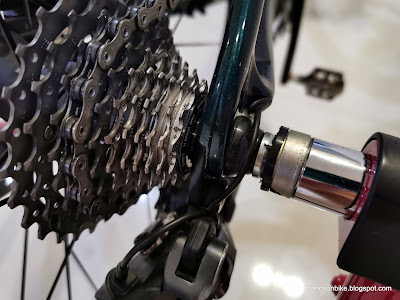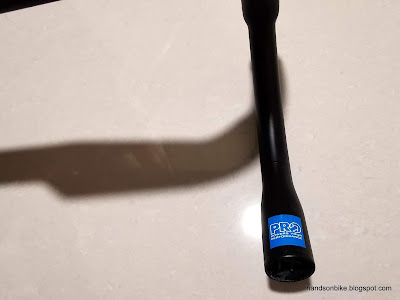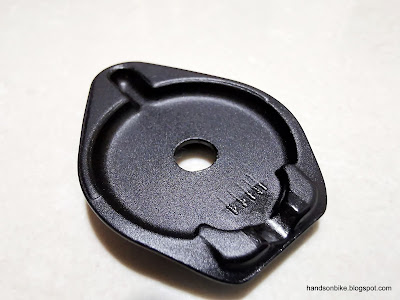I also want to do that, but my Cervelo Aspero is not compatible to the Minoura LR340 Bicycle Trainer. The problem is the rear axle type, which is incompatible between the bicycle and the bike trainer.
The trainer supports a quick release (QR) axle, where it will support the two ends of the QR axle. The QR axle has to be supported firmly to prevent movement during pedaling, and also to prevent damage to the frame or trainer. In fact the trainer comes with its own steel QR axle that must be used, in order to ensure compatibility and safety.
However, many new bikes that use disc brakes come with 12 mm thru axles, as already seen on the Canyon Endurace and also the Cervelo Aspero. It is not feasible to attach the thru axle directly to the Minoura bike trainer, as the interface shape is different and will not be able to hold the bike firmly and safely.
Aluminium nut with internal threads for the 12 mm thru axle, found on the drive side of the Cervelo Aspero. This shape does not match the interface of the Minoura bike trainer.
Thru axle lever on the non-drive side of the Cervelo Aspero. This lever shape does not fit into the bike trainer as well.
So I have a bike trainer and a bike, but no way to match the two of them together. I used to have a setup for small wheeled bikes as shown on the same post for the Minoura bike trainer, but I cannot find the small wheel adapter any more. Therefore I cannot use the folding bikes with this trainer as well.
Fortunately, there is a solution, which is what I want to share with everyone who is facing the same issue. The solution is to buy an adapter for the bike, so that it can be fitted onto the bike trainer. Of course you can also use an old bike with QR axles, or buy a new bike trainer.
I will be using the official Minoura thru axle adapter, with the Minoura bike trainer, so there should be no compatibility issues. If you are using it on other bike trainers, take note that the interface may be different.
Before getting the adapter, it is important to make sure that you get the correct adapter! The Minoura thru axle adapter is for 12 mm thru axles, but it comes in different thread pitches. This is due to the different thread pitch specifications used by different frame manufacturers. It is also another reason why thru axles are almost always included with the frame, as another thru axle may not fit. The normal thread pitches are M12 x 1.0/1.25/1.5/1.75 mm.
I almost bought the wrong adapter, as I thought my Cervelo Aspero uses the more common M12 x 1.5 mm thread pitch. Luckily I double-checked first, as I discovered that the front and rear thru axles have different thread pitches! Front thru axle uses the more common 1.5 mm thread pitch, while the rear has a less common 1.75 mm thread pitch. Since I will need the adapter to match the rear, I will need to get the M12 x 1.75 mm version.
Good that the thread pitches are labelled clearly on the Cervelo Aspero thru axles!
Official Minoura thru axle adapter. This is the spec for 1.75 mm thread pitch. There are basically only 2 parts.
Prior to getting this thru axle adapter, I had no idea how it would work as I could not find any instructions online. I thought I might have to figure it out myself after getting the parts. Luckily the adapter comes with its own instructions which are pretty clear. Here it is for those who are interested.
The two parts of the adapter goes into the two sides of the bike, and it is tightened using the steel QR axle that comes with the Minoura bike trainer.
Everything stays on the bike, except the original 12 mm rear thru axle which will be removed. The rear wheel stays on the bike. This thru axle adapter basically allows the steel QR axle to be installed, so that it can match the Minoura bike trainer.
This part goes onto the non-drive side of the bike, which is normally occupied by the thru axle lever.
When fully inserted, it supports the rear hub axle by connecting it to the frame dropout.
This is the other part of the thru axle adapter. The external threads (M12 x 1.75) goes into the female threads on the frame, while the internal threads (M5 x 0.8) will be used by the QR axle threads.
On the drive side, without the original thru axle. The thru axle normally threads into this nut from the other side, through the rear hub axle.
When this thru axle adapter is fully inserted, it will support the hub axle as well.
Thread in the thru axle adapter until it is fully inserted. I think hand tightening is enough to ensure no play.
I could not find the original Minoura steel QR axle, but I did find a steel QR axle from another brand that looks very similar. Only this part is needed, the nut and springs are not required.
Insert the steel QR axle from the non-drive side, and tighten to the adapter on the other side. Adjust the lever angle so that it can be tightened normally like a QR axle. The Minoura bike trainer will support this side of the QR axle.
The other side of the adapter will be supported by the Minoura bike trainer as well.
The steel QR axle fits well into the bike trainer.
The other side of the adapter also fits securely into the bike trainer.
The rotating lever on the bike trainer is used to clamp the bike between the two support points. The user manual states that once there is no looseness between the bike and the clamps, tighten the lever 2 more rounds and stop. There is no need to over-tighten the clamps or it will damage the frame or the bike trainer.
Cervelo Aspero installed onto the Minoura LR340 bike trainer! It feels secure and works pretty well.
Found a corner in my bedroom where there is a direct view of the TV, while being directly under the fan and aircon for good cooling and ventilation.
Signed up for Zwift, and managed to get everything working! So far what I have needed to get was only these Minoura thru axle adapters. I already have everything else needed for virtual cycling.
Zwift Device: Smartphone
Zwift Display: On TV via Chromecast screen mirroring
Bike Trainer: Minoura LR340
Bike: Cervelo Aspero with Minoura thru axle adapter
Power Meter: 4iiii Precision (left side only)
Cadence Sensor: 4iiii Precision
Heart Rate Sensor: Samsung Galaxy Watch
Power meter, cadence and heart rate sensors connected!
Since I am using my smartphone to receive the signals from the sensors, Bluetooth Smart sensors are necessary since the phone does not have ANT+. The 4iiii Precision power meter broadcasts in both ANT+ and Bluetooth which is fantastic. I was lucky that I had the Galaxy watch which can broadcast heart rate over Bluetooth. If I needed an ANT+ signal, I will use my Garmin Forerunner 235 as the heart rate sensor.
One of my first group rides in Zwift!
Just a 20 minute ride is enough to get me sweating buckets. Very efficient and productive way of training as you can ride consistently at a specific wattage without stopping, unlike when riding outdoors on public roads.
Lots of rubber bits from the rear tire after riding.
There will be a line on the tire where the roller contacts. Super grippy, like a slick F1 tire that has been warmed up.





































































